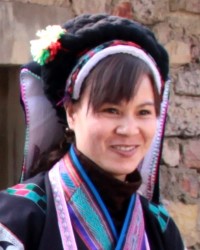Bouyei in China

Photo Source:
Yves Picq - Wikimedia
Creative Commons
|
Send Joshua Project a map of this people group.
|
| People Name: | Bouyei |
| Country: | China |
| 10/40 Window: | Yes |
| Population: | 3,577,000 |
| World Population: | 3,655,900 |
| Primary Language: | Bouyei |
| Primary Religion: | Ethnic Religions |
| Christian Adherents: | 0.70 % |
| Evangelicals: | 0.17 % |
| Scripture: | Portions |
| Ministry Resources: | Yes |
| Jesus Film: | Yes |
| Audio Recordings: | Yes |
| People Cluster: | Bouyei |
| Affinity Bloc: | Southeast Asian Peoples |
| Progress Level: |
|
Introduction / History
The Bouyei are one of the ancient peoples of Guizhou, having inhabited the province for more than 2,000 years. Thousands of Bouyei were burned at the stake during the Nanlang Rebellion in 1797. The horrific persecution forced many Bouyei to flee into Vietnam.
It appears that the official division between the Bouyei and Zhuang in China is defined by provincial borders. The Northern Tai speaking groups in Guangxi are labeled Zhuang, and those in Guizhou, Bouyei. Until one generation ago, the Bouyei were more commonly known as the Chungchia, a name meaning "people in the middle." A 1945 study of the Bouyei revealed they were "divided into five distinct tribes."
Bouyei—which has eight tones—is a Northern Tai language, similar (and in some places identical) to Northern Zhuang. There are three Bouyei dialects in China, although as many as 40 dialects have been incorrectly reported in the past. In 1995 the Chinese government decided to discontinue education in the Bouyei language, and now all schooling is conducted in Mandarin Chinese. Only 12% of the Bouyei have attended high school, one of the lowest rates among the 55 official minorities in China.
What Are Their Lives Like?
When a Bouyei woman is in the process of giving birth, they put a tree branch across the door to prevent intruders from entering. An altar to the spirits is erected to ensure the delivery goes smoothly. After the birth, the placenta is buried under the bed.
What Are Their Beliefs?
The Bouyei are polytheists. They also practice an ancient form of exorcism called nuo. "A family will hire a shaman to cast out demons of illness or bad fortune. Ceremonies include climbing knife ladders, walking on fire or glass, and other activities to demonstrate the power of the spirits."
Catholic missionaries have worked among the Bouyei for 200 years. Many were martyred for their witness. The CIM missionary J. F. Braumton arrived in Guiyang in 1877. A mission station was opened in Dushan in 1895, but "the time of the missionaries was entirely given up to work among the Chinese." In 1985 there were nine Catholic churches in the Qianxinan Prefecture. Several mission agencies commenced church planting efforts among the Bouyei in the late 20th century.
What Are Their Needs?
The Bouyei people need to submit to Jesus Christ so they can experience the abundant life he offers them in John 10:10.
Prayer Points
Pray for bold workers who are driven by the love of the Holy Spirit to go to them.
Pray for an unstoppable movement to Christ among them.
Pray for the authority of Christ to bind hindering spiritual forces to lead them from darkness to light.
Pray for signs and wonders to happen among them and for great breakthroughs with a rapid multiplication of disciples and house churches.